It all started during the summer of 2015 when I decided that it was time to part ways with MAGIC, my 1962 Alberg 35′ glass sloop. I had spent four years and countless hours restoring MAGIC to her former glory, but two years after re-launching I needed a change. While she was not a big boat by today’s standards, the amount of time and money spent just keeping the boat in the water and in good condition was exhausting. The fact that I lived in central New Hampshire and kept the boat 150 miles away in southeastern Massachusetts only made things worse.
I found myself spending more and more time on a beat-up old O’Day Daysailer that had been following me around since college. My family and I romped around the local lakes and estuaries, sailing hard and often. The only money I spent on her was gas for the car and beer for the cooler. At some point that summer, I realized that I was having as much fun on the O’Day as I was on MAGIC, but with none of the stress. Sure, MAGIC was a comfortable boat that could take somebody sailing for weeks at a time, but I was mostly going out for day sails with an occasional overnighter. I could be doing the same thing on a much smaller boat.
At about the same time, I heard about the Small Reach Regatta, organized by the Downeast Chapter of the Traditional Small Craft Association in Maine. It’s not a race, but a gathering of small, traditional sailing and rowing craft. I have always been drawn to the look of classic boats and when I saw the boat lineup on the Small Reach Regatta website, I knew I had to check it out.
I showed up on the first morning of the event and was able to sail on Mike Duncan’s FRISKY LADY (a Chamberlin 15′ 6″ gaff sloop) and on Geoff Kerr’s NED LUDD, an Oughtred 19′ 6″ Caledonia yawl. I fell in love with the Caledonia but it was a bigger boat than I needed. However, the seed had been planted, and I spent the rest of the summer researching the perfect small boat in the range of 15′ to 18′.
The boat had to be pretty and, while I prefer the look of lapstrake, there is a lot of additional setup and framing required that takes a fair amount of time, so I was looking for a stitch-and-glue design that didn’t require a strongback and associated framing. I also like the classic look of a balanced lug-rigged yawl; and with unstayed spars, balanced lug rigs are really easy to set up for launching. The mizzen makes for easy handling. In spite of the appeal of classic boats, I wanted a fast boat, and a planing hull makes this possible.
The Apple 16, a five-strake stitch-and-glue balanced lug yawl designed by Thomas Dunderdale of Campion Sail and Design, came closest to being everything I wanted. The classic lines and balanced lug yawl were just what I was looking for and the somewhat flat aft section of the hull allows the boat to get up on a plane. I’m a sucker for a plumb bow, so as soon as I saw pictures of the Apple 16, I knew it was for me.
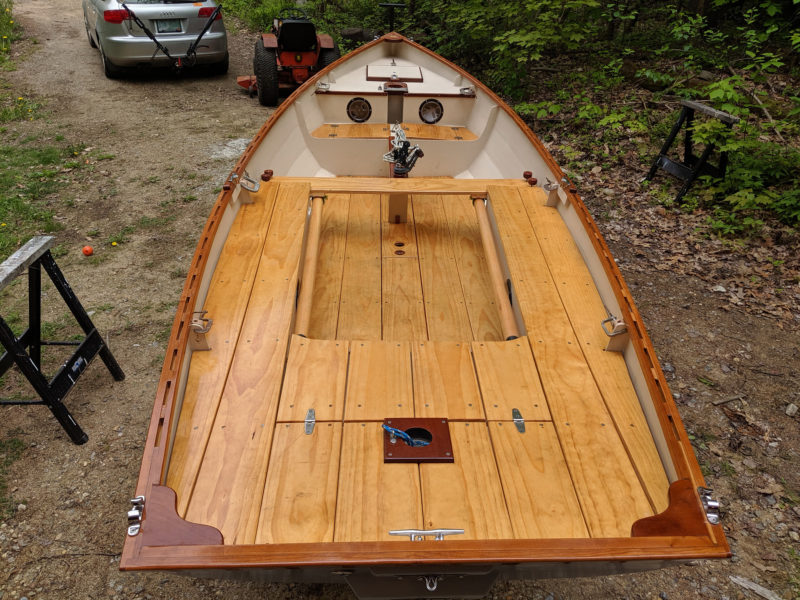 Photographs by Jacob Bowser
Photographs by Jacob BowserThe plans detail several interior layouts, and provide the option for decked ends . The author designed his own interior with flotation tanks and a removable center thwart.
After several conversations with the designer, I purchased plans and began the build. Thomas was very helpful, answering all of my questions via email or phone.
I didn’t want to wait for a shipment of full-sized printed plans mailed from England; I opted for digital files and took them to a local copy shop and had them enlarged for about $30. I was really happy with the amount of thought and detail that went into the plans; they came with a general construction narrative, a detailed 30-page keyed construction index and at least a dozen schematics for the boat, parts, and interior layout options. For a first-time boat builder, everything provided should be easy to follow.
The included materials list calls for four sheets of 6mm marine plywood scarfed lengthwise for the hull, two sheets of 6mm for bulkheads and interior framing, and one sheet of 9mm for the rudder and additional components.
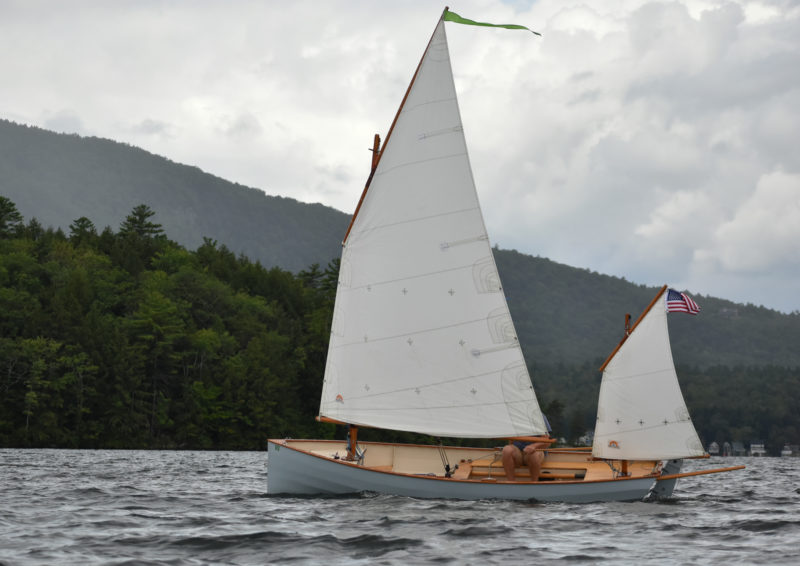
With a solo skipper aboard, the Apple 16 can, in spite of its traditional appearance and rig, get on plane in a moderate breeze.
While Campion does not currently offer files for a CNC mill, someone savvy with a CAD system should be able to digitize the planking measurements and send them off for cutting to save time. I don’t have easy access to a CNC mill, so I opted to plot the strakes on the scarfed panels and cut them out myself. The plans package provides both a table of offsets and a visual diagram for plank measurements that is very intuitive.
Probably the best thing about building a stitch-and-glue boat is how fast you can make visible progress. Once you cut the strakes from the scarfed plywood panels, assembling the hull is a simple matter of drilling out holes for wire or zip ties (I opted for zip ties) and stitching the panels together. In a single, albeit long, afternoon you can go from a pile of flat plywood pieces to a structure that resembles a boat.
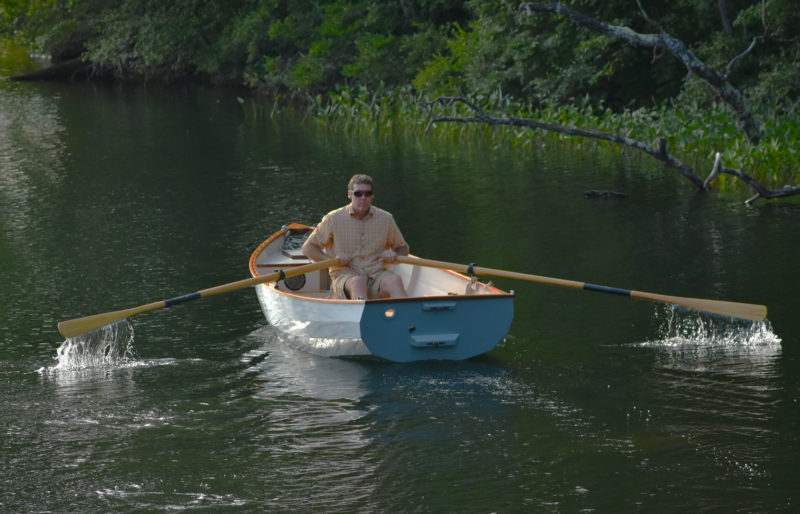
The author could comfortably row the Apple 16 at around 3 knots. His sectional oars, with carbon-fiber ferrules, stow neatly out of the way while sailing.
Of course, it’s not all a piece of cake. Until you get the bulkheads tied in, the entire structure is a bit of a wobbly mess. I cut cradles to steady and align it while I tied everything together. This helps immensely when one is working alone.
The job of taping the inside and outside seams, followed by a layer of 6-oz ’glass on the outside of the hull is rather monotonous. If you’re careful, cleanup should be a relatively minor job and once complete, you can move on to fitting out the interior.
The plans provide layouts for several interiors ranging from a spartan setup of three thwarts, with two doing double duty as mast partners, to a more extravagant layout with decks fore and aft. I deviated from the plans and designed my own interior with built-in flotation compartments and a center thwart that’s removable for camp-cruising.
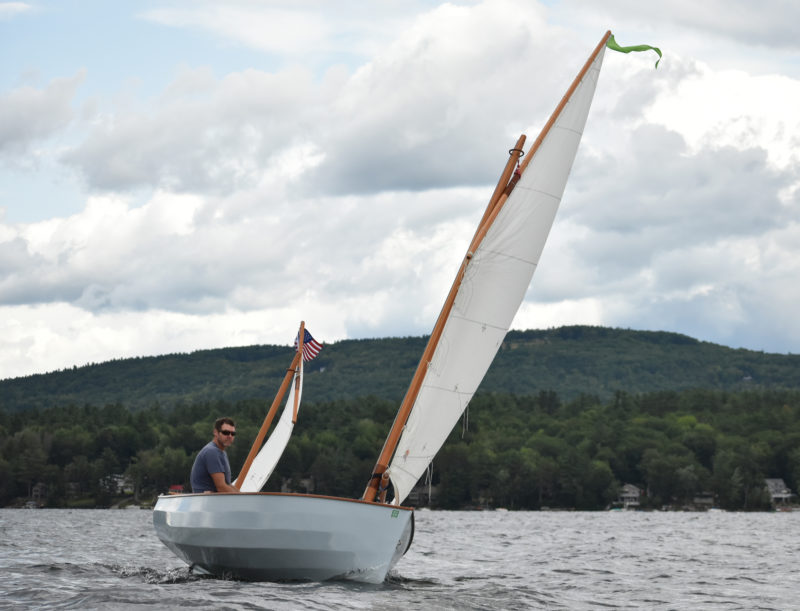
The boat is quite light, and a solo sailor could add some ballast to stiffen the hull against the press of the sails. The designer recommends adding between 110 to 275 lbs if ballast is needed.
The plans call for a long, open daggerboard trunk to accommodate multiple mizzen sail plans (the larger plan changes the center of effort and requires the daggerboard to be located further aft). Since I was only building the version with the smaller sail plan, I shortened the daggerboard trunk after consulting with Campion.
I also increased the thickness of the daggerboard from 25mm to 33mm so I could build a NACA 0012 foil. I’ve had several opportunities to test performance against other similar designs with balanced lugs and I believe that the foil helps with upwind performance.
All told, the build took me about eight months of working 10–15 hours per week, and I couldn’t be happier with the way it turned out. A single rower with 9.5’ oars can propel the boat at 3 knots when rowing at a comfortable pace, and her sailing ability has exceeded my expectations. Trailering with my four-cylinder Rav 4 is easy.
I’ve had the boat out for dozens of times in a variety of wind conditions, and the boat is really amazing to sail. Having no prior experience with balanced lug rigs, I spent a lot of time researching balanced lug sail tuning and after a bit of trial and error, I opted to go with 6:1 downhaul and 4:1 mainsheet tackle. I used Dyneema line for the downhaul and main halyard to maximize luff tensioning ability.

The Norwegian tiller may take a bit of getting used to if you haven’t used one before, but it is the simplest arrangement for getting around a mizzen mast and has a number of advantages over a conventional tiller.
With the rigging configuration sorted out and making sure the downhaul tension is drum tight, I found that the pointing ability was quite good. Combined with the foil daggerboard, which should theoretically increase lift, the Apple 16 is not far off the pointing angles that a similarly sized Bermuda-rigged boat can achieve. When soloing, I regularly get up on a plane on a reach and hit 8.5 to 9 knots in less than 15 knots wind. Over 15 knots and I put in a single reef, and have sailed in conditions up to 23 knots without being terrified.
We have had four adults out for a sail, and while it is manageable, two of the crew need to sit in the well on either side of the daggerboard trunk forward of the thwart. The 250-lb boat is really best suited for one or two, and each additional crew member reduces the boat’s ability to plane. I have yet to be able to get the boat on a plane with more than two crew on board; I suspect that it would have to be pretty windy to do so. With that said, the boat sails well even with four on board.
The boat is as well-mannered as a light boat can be and is reasonably dry in most conditions. Beating close-hauled into chop over 2’, predictably, tends to be the wettest point of sail. The yawl rig contributes to a very balanced helm on all points with just enough weather helm on the Norwegian push-pull tiller to take any of the play out of the system and allow you to make subtle course corrections.
The Campion Apple is a well-thought-out small boat that is lively to sail and will turn heads in any harbor. It’s a good choice for a first-time boatbuilder with woodworking skills who doesn’t want to spend years building a boat that looks and sails great.![]()
Matt Bowser, a software engineer living in Canterbury, New Hampshire, can’t remember a time when he wasn’t obsessed with boats. He grew up sailing the coast of New England from Rhode Island to Maine and is enamored with the simplicity, ease, and low maintenance of small boats. When he isn’t sailing, building, or fiddling with various boat bits, he’s mountain biking in the forests of New Hampshire and Vermont or trying to get his teenage children to hang out with him.
Apple 16 Particulars
[table]
Length/15′ 10″
Waterline length/14′ 4-1/2″
Beam/5′ 3″
Draft, board down/3′ 9″
Sail Area/123 sq ft
Ballast, if used/110 lbs to 275 lbs
[/table]
Plans for the Apple 16 are available from Campion Sail and Design, based in the UK. Prices are in Pounds Sterling: £65 (approx. $79 USD) for PDF, and £120 (approx. $146 USD).
Is there a boat you’d like to know more about? Have you built one that you think other Small Boats Magazine readers would enjoy? Please email us!
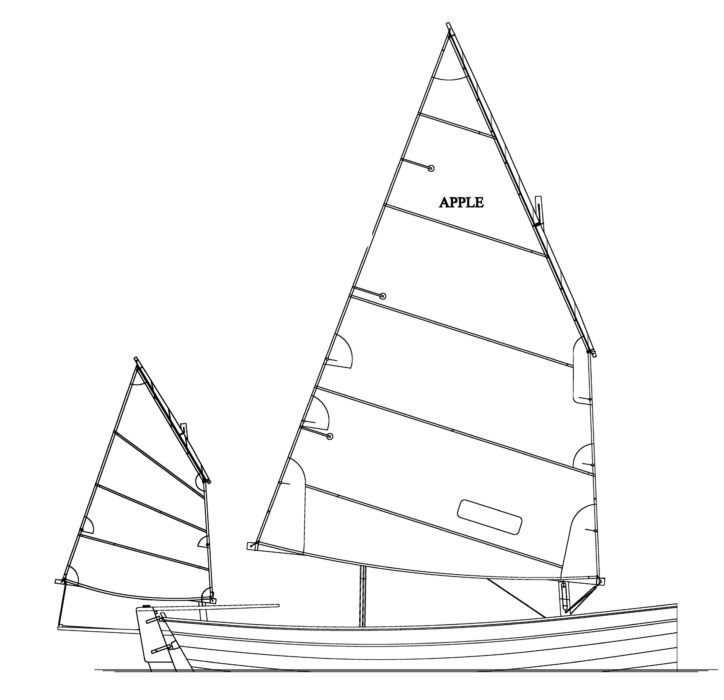
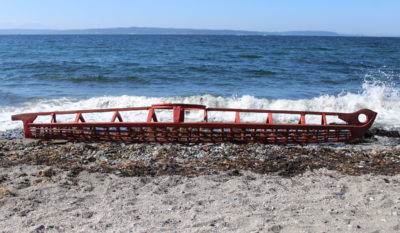
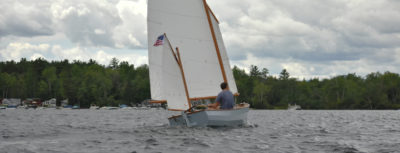

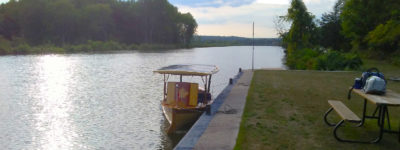
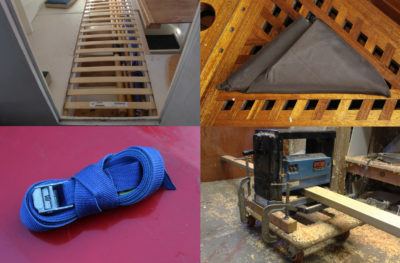
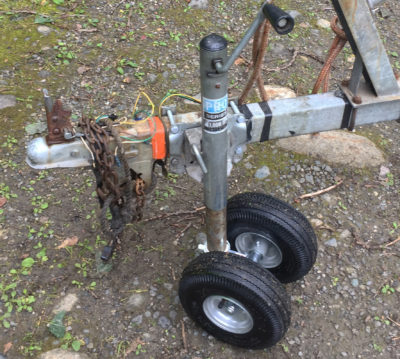
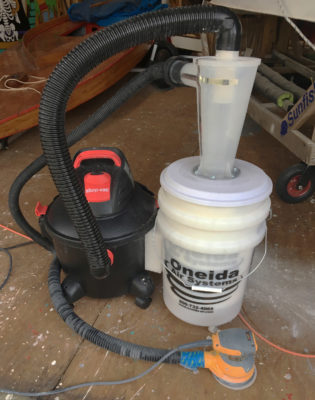
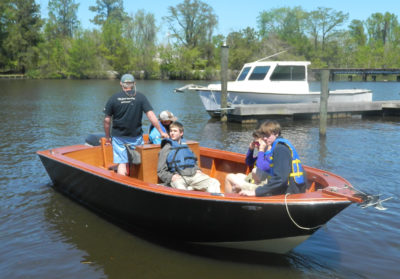
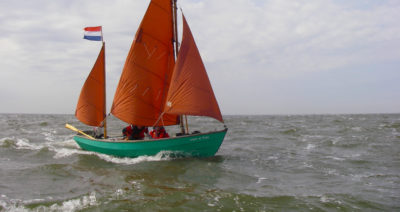
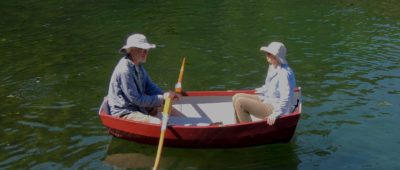
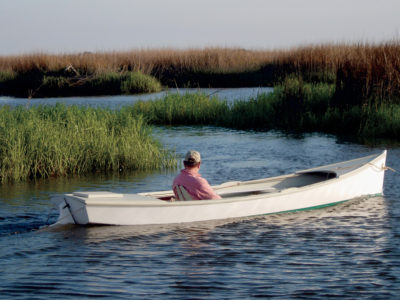
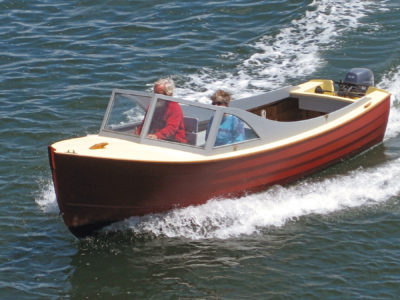
What a great design. Been looking for years for 16′ open sailboat that is clinker-glued that can be rowed, sailed, and motored. Easily big enough for two and a third person if need be. Similar to Oughtred’s Fulmar but lighter for when singlehanded. Great boat!
There was a Fulmar at the Small Reach Regatta this year and comparing the 2 boats side by side, the Fulmar is a much bigger boat. The Fulmar is 16′ 7″ x 5′ 10″ and the Apple 16 is 15′ 10″ x 5′ 3″. The 9″ difference in length and the 6″ difference in beam really makes for a lot more room than the Apple. The Fulmar was high up on my list for builds before I chose the Apple, but as I said in the article: I’m a sucker for plum bows.
That’s right Matt. The Fulmer is a much more roomy boat, but at my age and low weight I couldn’t see myself handling it by myself, so I went for Ross Lillistone’s First Mate and was pretty pleased with the choice.
Yes, this size is hard to come by, that’s why my First Mate is 16’ x 5’4” and includes a leg-‘o-mutton mizzen and a second mast step 10” forward of the original. Balanced lug as well. Look for it in the Salish 100 this summer.
There are advantages to water ballast in a boat like this, in the form of two to four 5-gallon water carriers, the collapsible kind. The main advantage is that the ballast is neutral buoyancy in case of a capsize or swamping, and is easily shifted around to where it’s needed. Of course it’s bulky compared to lead pigs or sash weights, but won’t send you to the bottom in case of bad luck (or judgment).
I’m so glad to finally see a Tom Dunderdale design profiled here. His Apple and smaller Pearl designs are gorgeous. Love the British workboat aesthetic.
Nicely done sir. Ahh yes, the plumb stem, what is it about that? I had in the back of my mind this would happen after I started my build (Argie 15), “buyers remorse”, is there a nautical term for that? I love the honest lines of the Argie, AND am holding out for her to deliver on versatility as an outboard skiff. But your talk about planing sounds next level performance. Thanks for the report.
Beautiful design, and well-written article. Thanks. Like most of us on this site, I suppose, I, too, am obsessed with traditional small sailboats. I have never considered stitch and glue very seriously, but this article sets me wondering, which is, of course, the highest accolade of all.
Matt,
I mostly sail solo, would it be advisable to have water ballast tanks if I build a Campion ? Along with reef points on the main sail, I weigh about 150 pounds.
Sincerely,
Danny
Matt,
Great looking boat and impressive approach to thinking through the design fit and modifications you adopted.
I’ve built a Swallow Boats Storm 15 Balanced Lug and will be introducing a few post build mods this year. For the moment though I’m most interested in any references you had to lug tuning including and beyond tensioning – e.g. like how much sail to have forward of the mast, at the yard and at the boom, how to find luff and foot tensions.
Any “learnings”/ refs would be greatly appreciated.
Trevor